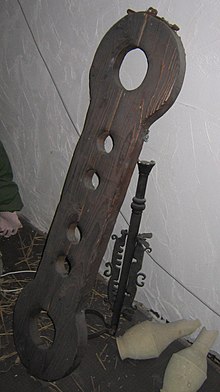This is an old revision of this page, as edited by Gwen Gale (talk | contribs) at 08:33, 4 May 2008 (I think cites are at least ok now). The present address (URL) is a permanent link to this revision, which may differ significantly from the current revision.
Revision as of 08:33, 4 May 2008 by Gwen Gale (talk | contribs) (I think cites are at least ok now)(diff) ← Previous revision | Latest revision (diff) | Newer revision → (diff)

A shrew's fiddle or neck violin is a variation of the yoke, pillory or rigid irons whereby the wrists are locked in front of the bound person by a hinged board or steel bar. It was originally used in the 18th century as a way of punishing women who were caught arguing or fighting.
History
The shrew's fiddle was first used in places such as Germany and Switzerland, where it was known as a Halsgeige, meaning "neck viola" or "neck violin". It was originally made out of two pieces of wood, fitted with a hinge and a lock at the front. The shrew's fiddle consisted of three holes. One was a large hole for the head and neck to fit through; the other two were smaller holes which fastened the arms in front of the victim.
It was first used to punish women who were caught fighting or arguing with other people. The husband of the woman would sometimes birch or flog his wife as further punishment. Another version was the "double fiddle", which allowed two people to be attached together, face-to-face. This forced the two people to talk to each other. They were not released until the argument had been resolved.
References
- ^ "Rothenburg ob der Tauber - Criminal Museum shows Iron Maiden, neck violins and Chastity belts". Retrieved 2008-05-04.
- ^ "Museum of Medieval legal history - Halsgeige (neck-viola) and Shame-mask - Medieval torture". Retrieved 2008-05-04.
- ^ "Rothenburg". Retrieved 2008-05-04.